Cultured Cashew Cream Cheese Spread

 Add to favorites
Add to favorites

This raw, vegan, cultured cream cheese is produced without antibiotics, synthetic hormones, or pesticides. And best of all, it is cultured. Not only does it taste great, but it is creamy, with a soft texture for amazing spreadability.
When it comes to replicating dairy products, there are a couple of requirements that must be met: flavor and texture. Without paying attention to those two criteria, it will be a hard sell. Our end goal is to provide health-boosting foods that leave us feeling good about what crosses our palate and fills our bellies.
Health Insurance Plan
Getting people to enjoy healthy foods is like drawing up a health insurance plan for them. The initial cost of the plan is getting them to let go of expectations. The plan may seem a bit extravagant in the beginning, but we need to understand that this is a lifetime investment–one that gives us peace of mind, knowing that we are doing our best to enhance the future for ourselves and for those we love.
My Plan
I am not here to sell health insurance. Well…in a roundabout way, it appears I am. My plan is to share recipes that not only taste amazing, and look amazing, but are healthy for you, as much as possible. Does that sound like a good insurance plan to you?
My Approach to Vegan Cream Cheese
First, let’s talk about texture. If you create a cream cheese that is chunky or grainy, it will be difficult to expect anyone to come back for seconds. There are three things that go into creating silky-smooth texture.
- You need a high-powered blender. Just like those who demand to own the best tools that are housed in the garage, we too need the best tools in the kitchen. My recommendation is either a Vitamix or Blendtec.
- Cashews lend a super creamy base when soaked and blended. Alternatively, soaked, skinned almonds could work, but cashews are the best.
- Flax gel is something that I have been tinkering with for more than a couple of years now. It is optional in this case, but I do believe that it helped create this amazing recipe, and it also provides great health benefits. I provided a link down below on how to make it.
- Coconut butter helps to stiffen the cheese when it chills in the fridge. Blended cashews on their own will thicken as they chill, but as I said before, my goal was to create more of a dairy cream cheese texture. Through all these ingredients and techniques, I was able to achieve that.
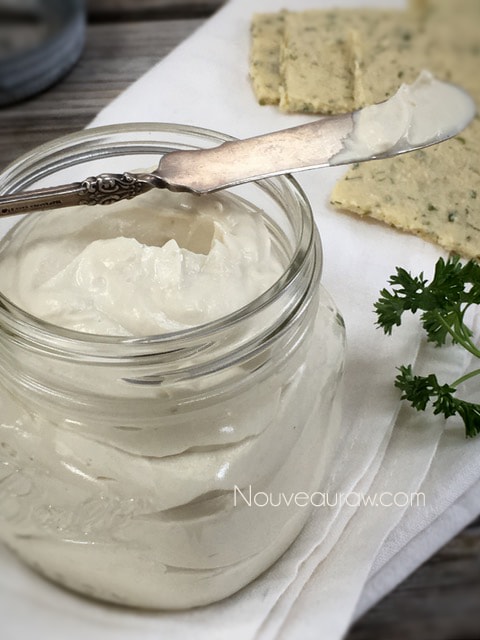 Ingredients:
Ingredients:
Preparation:
Soaking the cashews
- Place the cashews in a glass bowl, along with 4 cups of water.
- Soak for at least 2 hours. Read more about why (here).
- The soaking process will help reduce phytic acid, which will aid in digestion.
- The soaking also softens the cashews, so they blend nice and creamy.
- After the cashews are through soaking, drain and rinse.
Blending the cheese base
- Drain the soaked cashews and discard the soak water. Place in a high-speed blender.
- In a high-powered blender, combine the cashews, water, bell pepper, onion, chives, and flax gel.
- To get the creamy texture we want, it is important to use a high-powered blender. It could be too taxing on a lower-end model.
- Blend until the filling is creamy smooth. You shouldn’t detect any grit. If you do, keep blending.
- This process can take 2-4 minutes, depending on the strength of the blender. Keep your hand cupped around the base of the blender carafe to feel for warmth. If the cream cheese is getting too warm, stop the machine and let it cool. Then proceed once cooled.
- Add the probiotics and blend just until incorporated. Please make sure that it doesn’t get too warm, which will kill the probiotic bacteria.
- I provided a link above that will take you to my Amazon store. I have several probiotics listed there that I use for recipes like these. They come in capsules, and I empty them out into a measuring spoon.
Fermentation process
- First and foremost, make sure all the utensils and pieces of equipment you use for culturing are sterilized to avoid growing bad bacteria.
- If at any time mold–fuzzy, black, or pink forms–your cheese will need to be tossed.
- Place the cheese mixture into a medium-sized glass bowl, cover with cheesecloth (or breathable cloth), and allow the mixture to ferment (culture) at 115 degrees (F) in the dehydrator for 12 hours.
- I found that my 9 tray Excalibur worked perfectly for this process, since it has a large cavity that will hold bowls.
- If you don’t own a dehydrator that will accomodate a bowl, you can use your oven. Do not turn the heat on. Place the bowl in the center of the oven, shut the door, and turn on the oven light. The light bulb alone will produce some heat. Mine reaches 100 degrees (F), so please test yours. At a lower temperature, the fermenting process will take a bit longer.
- Keep in mind there is no hard and fast rule about how long the cheese needs to culture. Your tastebuds will have to guide you in determining the right length of time.
The end blend:
- Transfer the cheese base to the food processor and add the coconut butter, maple syrup, and salt.
- Process until well incorporated, making sure to stop now and then to scrape down the edges of the bowl.
- Place in an airtight glass container and chill overnight to help create a firmer, spreadable texture.
- This should keep for several weeks. Use all senses to determine freshess.
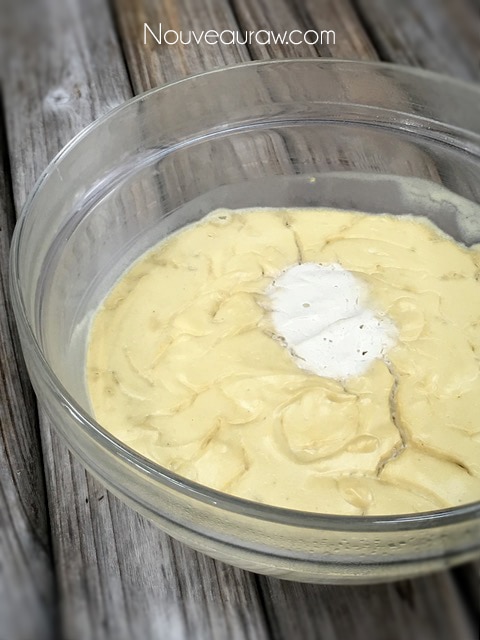
In the photo above, do you see a white spot in the center? My cheesecloth
was resting there during the culturing process. No biggie.
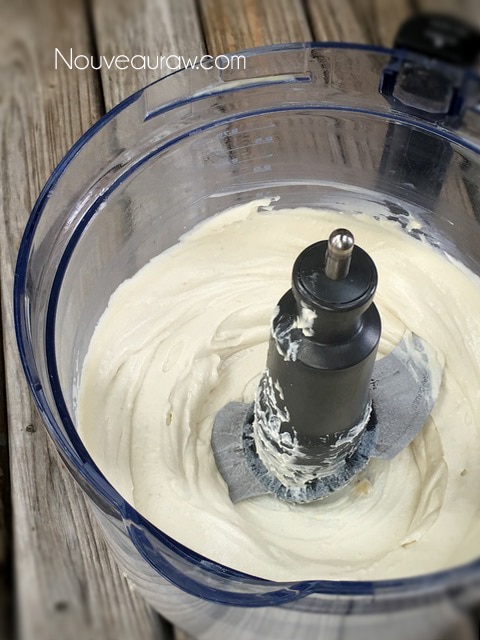
Blend until smooth and creamy.
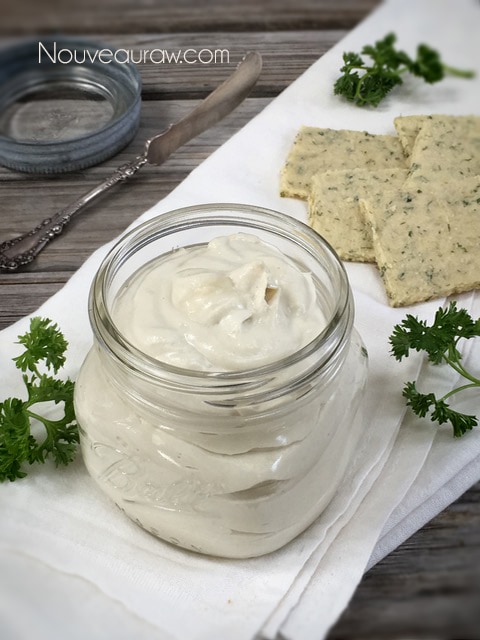
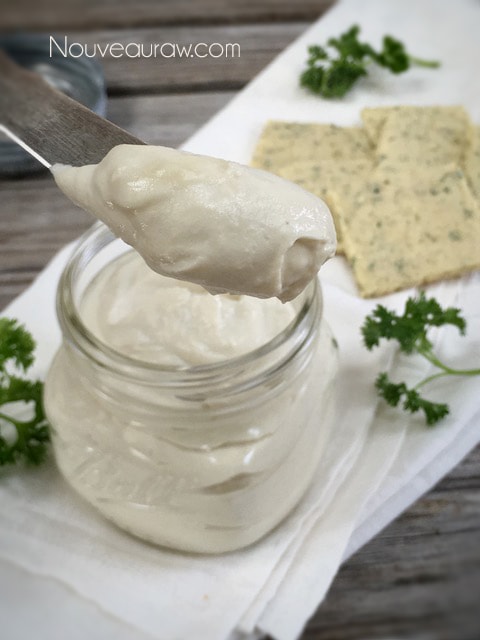
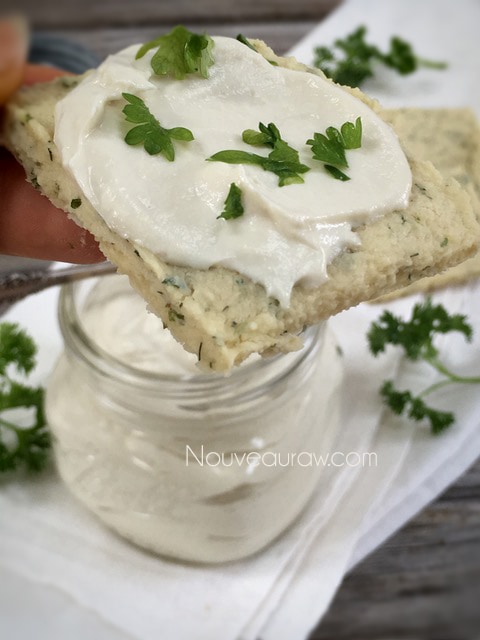
© AmieSue.com
Tags: Cultured, Dairy Free, Gluten Free, No Dehydration Required, Refined Sugar Free, Soy Free, Vegan



 Add to favorites
Add to favorites
 Ingredients:
Ingredients:
Hi Amie, what substitute can be used for the maple syrup? I am on an all sugar free diet. Thank you!!
Hello Svetlana, You can omit the maple syrup. It is there for flavor balancing and cream cheese normally has a a hint of sweetness to it. Otherwise, you could add a drop or two of Liquid stevia if you use that in your sugar-free diet since it doesn’t effect your insulin. Blessings, amie sue
Thank you so much!! Another question. What kind of crackers would go with this cream cheese the best? Please give me some names and I will look for the recipes on your website. Also, what else I can use it with? Many thanks :))
Good morning Svetlana,
Oh you bet… I will be right back with some ideas…
Creole Seeded Crackers – https://nouveauraw.com/raw-recipes/crackers/creole-seeded-crackers-raw-vegan-nut-gluten-free/
Flakey Club Crackers – https://nouveauraw.com/raw-recipes/crackers/flakey-club-crackers/
Apple Cinnamon Cracker – https://nouveauraw.com/raw-recipes/crackers/apple-cinnamon-cracker/
Caramelized Onion Crackers – https://nouveauraw.com/raw-recipes/crackers/caramelized-onion-crackers/
Caraway and Dill Crispy Crackers – https://nouveauraw.com/raw-recipes/crackers/caraway-dill-crispy-crackers-raw-vegan-gluten-free/
I am going to go out a limb here and say that this spread will compliment just about any cracker or even bread recipe on my site. :) Keep me posted how it goes. Blessings, amie sue
Hi Amie Sue! As you suggested, I should’ve just skipped any sweetener for the cheese spread. Instead, I added some stevia and now I hate the aftertaste of it. :(( other than that, everything worked great!!
Thank you so much for the crackers recipes :)))
Oh bummer Svelana. Stevia can be tricky to work with. Over time, I have only come to enjoy one stevia which I use daily. To me it doesn’t have any bitter aftertaste, it’s NuNaturals liquid stevia. And it’s easy to over do it… If you find this spread now to unbearable to enjoy I would suggest trying to make a cracker of out of it. If it were me, I could place the spread in a large bowl and add enough dried (unsweetened) shredded coconut to it until it is a thick batter. Then spread it on non-stick dehydrator sheets about 1/4″ thick. Score into cracker sizes, sprinkle sea salt on top, and dry for about 16 hours or so. Once dry enough, flip it over onto the mesh sheet and remove the nonstick sheet to speed up the drying process.
Have fun in the kitchen and never give you! You are doing great. :) Blessings, amie sue
Thank you for such creative advice, Amie Sue!!! I will do it for sure! – Don’t like throwing food out :))
You bet Svetlana :) Blessings and have a great day. amie sue
Hi Amy Sue, Sorry I did not have time to tell you that crackers came out quite great! the food wasn’t wasted :)) How long these crackers can be kept? Do they have to be in the fridge because of fermentation or don’t?
Thank you very much!!
Awesome Svetlana. Thanks for trusting me and giving it a try. :) I am not sure on the shelf-life, often it will depend on how long you left in the dehydrator, which determines how moist or dry they are. But if it were me, I would leave some out to enjoy and then store the rest in the freezer. This way you have some for later days as a treat. Just keep them in airtight containers. Have a blessed day, amie sue
Good Morning Amie-Sue,
So many recipes begin with soaked cashews which then are blended into a cream .This year I would like to make a large batch of cashew cream then divide it into the measurements for my favorite Divine NouveauRaw recipes. All of which I would like to freeze. Doable without concern, yes? How about freezing cultured casew cream ?
Good afternoon :)
To be honest, I haven’t frozen the cashew cream before. I have tested my cashew based frostings and they do ok. It should be fine but I would like to recommend making a small batch and freezing it. Check it in a week so make sure the texture isn’t lost. It may be to be whipped back up in the blender once thawed, in fact I am positive that it will. :) Same goes for the cultured cashew cream… though I don’t recommend freezing that one because freezing does kill some the health benefits to the probiotics. I hope this was helpful. Blessings, amie sue (P.S. keep me posted)
Just popped it into the fridge. It tastes incredibly delish. Onto the crackers! Thanks Amy!
You are so welcome Angela. I appreciate the feedback. :) Enjoy and have a happy day, amie sue